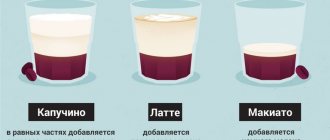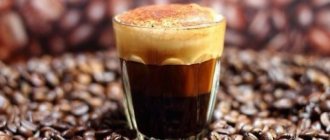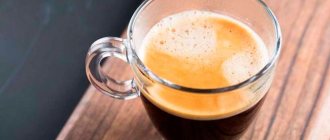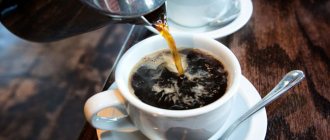A cup of coffee is a good excuse for a friendly meeting, an indispensable attribute in business negotiations and just a good way to relax after a hard day at work. At the same time, everyone compares coffee based on their own criteria, choosing the best for themselves.
When visiting a cafe, you can get confused by the huge variety of types of coffee. We are offered mocha, latte, espresso and other types of coffee. In restaurants and cafes, coffee drinks are prepared by baristas using special expensive equipment. They know all the intricacies of preparing this or that drink, so coffee in specialized establishments is of excellent quality and taste.
The price range for all types of coffee is approximately the same, but the taste can differ radically.
So how not to get lost in such abundance and make the right choice? Very simple! It is enough to know what ingredients it consists of and how this or that coffee drink is prepared. Today we will also compare the most popular types of coffee, namely latte, cappuccino, Americano and espresso.
Similar but different
Let's find out what kind of coffee it is: espresso, milk and foam. Cappuccino and latte fit the description. These are similar, but different drinks.
Interesting! Various popular types of coffee, their descriptions and methods of preparation in coffee shops
Latte contains 127 kcal, 75% milk or cream. The foam is light, airy, has a soft milky taste, the standard portion is 250-300 ml.
Cappuccino contains 68 kcal, 66% milk or cream. The foam is dense, glossy, coffee flavor predominates, standard serving is 180-200 ml.
The caffeine content is the same – 40-60 mg.
Where is the price higher?
The cost of a latte is more expensive than a cappuccino. Although the ingredients from which the two types of coffee are made are similar, their proportions are different. Therefore, lattes tend to be more expensive than cappuccinos because they require more milk.
Although sometimes in fast food establishments there is similarity in the price of this product. This is due to the fact that the same glass volume is used for latte and cappuccino, for example, 0.3 liters. or 0.5 l. But this approach is not considered correct, since to achieve the ideal taste of coffee, a certain volume is required: latte - 250-350 ml, cappuccino - 150-200 ml.
Cold coffee drinks
Frappe
Frappe coffee is prepared using a shaker or mixer based on one or two shots of espresso, sugar and a small amount of water, which are whipped until foamy. The drink is served in a glass glass with the addition of cold water, ice and milk.
Ice latte
Methods for preparing iced lattes may vary. One popular recipe involves mixing cold milk, syrup and crushed ice and then adding espresso to the mixture.
Thai coffee (Vietnamese coffee)
tatyanaseverydayfood.com
A cold coffee-milk drink is prepared as follows: add condensed milk and coffee to a glass with ice, then pour in milk or whipped cream. However, adding the last two ingredients is not necessary.
Cold brew
squarespace.com
A coffee drink that is prepared by dripping cold water through a layer of coffee or steeping ground coffee in non-hot water for a long time. However, preparation methods may vary: some brew cold brew hot and then cool it sharply.
Nitro coffee
arizonacoffee.com
Nitro coffee is not so much a type of coffee drink as it is a method of preparation that makes the coffee carbonated. Typically, nitro coffee is a carbonated version of cold brew.
Espresso tonic
A refreshing coffee drink made with espresso and tonic. Lemon, cold water and various syrups are also often added.
Innings
The significant difference is in presentation. Espresso is served with a glass of clean, cool water. You should drink it first to prepare your taste buds for the noble drink. A serving is only a few sips, so you need to drink it right away, hot.
No sweets or pastries are served; this drink is good on its own. People drink it in the morning in coffee shops on the way to work. Moreover, in this case they do not sit at the table, but wait for the ordered cup right at the bar counter. This recipe is also appropriate during business meetings.
Americano is served ready-made or in two cups: one with coffee, the other with hot water.
An important difference: you can drink it chilled and even with ice. A large portion is complemented with chocolate, cheese or donuts
This option is often used as “coffee to go”, so it is sold in cardboard or plastic cups with a lid and straw, making it convenient to drink on the go. Suitable for friendly get-togethers.
Options for Espresso-based coffee drinks
Cappuccino – A classic favorite
1/3 Espresso
2/3 frothed milk + high layer of milk foam
Cappuccino is an Italian drink consisting of espresso, a layer of frothed milk and a layer of milk foam. A cup of Cappuccino quickly gives you a boost of energy, thanks to the caffeine content, which does not greatly affect the taste of the drink. Cappuccino coffee is known for its harmonious combination of taste and attractiveness.
The main reason for the popularity of Cappuccino is, of course, the aesthetic and presentable appearance of this drink. The cappuccino is served in a porcelain cup, over the edge of which the airy silky foam rises beautifully.
Latte (Caffè Latte / Café Au Lait / Grand Crème) – Milky delight
1/3 Espresso
2/3 frothed milk + a thin layer of milk foam
In Europe, this drink has many different names, but they all literally mean “coffee with milk”, and Americans simply call it Latte. In the traditional preparation method, frothed milk is added to a shot of Espresso to form a small amount of foam. The American version of the latte has a larger layer of milk, but it is still not as high as a cappuccino.
Often, thanks to the skill of the barista, a portion of the prepared Latte turns into a real work of art - latte art.
Macchiato (Caffè Macchiato) – Darker coffee
100% Espresso + a small layer of milk foam
Macchiato is a combination of “espresso + milk”, which is made in such proportions that the pure, rich taste of coffee beans is preserved in the brewed drink.
Therefore, the drink contains only a slightly noticeable layer of foamed milk, which is added to the double shot of Espresso. The coffee settles under the foam, or a little higher. Among all Espresso-based coffee drinks, Macchiato has the highest Espresso content in the proportion of ingredients. The main idea is to ensure that the taste of the milk does not dominate the taste of the coffee.
Latte Macchiato – Variety of Macchiato
2/3 frothed milk
1/3 Espresso + a thin layer of milk froth
This coffee drink is often confused with Coffee Macchiato, although Latte Macchiato is lighter and less rich. Besides the difference in taste, they differ slightly in the way they are prepared - Latte Macchiato has espresso coffee (usually just ½ shot) poured into milk, as opposed to Coffee Macchiato, which has milk poured into espresso (full or double shot).
This drink is usually multi-layered - this is clearly visible when serving Latte Macchiato in a glass cup. Typically the bottom layer is frothed milk, followed by espresso, and then a thin top layer of milk froth. The coffee drink turns out to be light - much lighter and less invigorating.
Americano (Caffè Americano) – Dark and scalding
½ Espresso
½ water
Americano is a combination of espresso coffee and hot water. Although at first glance it may seem like an ordinary drip coffee, there is a big difference in the aftertaste of these two drinks.
According to rumors, Americano got its name during World War II, when US infantrymen tried to find a suitable recipe for a coffee drink - a balance between the rich, full-bodied taste of Italian espresso and traditional American taste preferences.
Flat White – A drink from the other side of the world
2/3 Espresso
1/3 frothed milk + microfoam layer
First appearing in Australia, Flat White - in the lane. from English “flat white” quickly became popular all over the world. The drink is a combination of steamed milk, a double shot of espresso and a thin top layer of milk microfoam.
Breve – Coffee with whipped cream
½ Espresso
½ frothed milk and cream (half and half) + a thin layer of foam
Breve consists of a foamed mixture of milk and cream (half and half) that is added to espresso, and a small layer of foam that covers the drink. Although Breve is not as invigorating as many other coffee drinks, it is very smooth and enjoyable to drink.
Espresso Con Panna / Café Viennois – A touch of history
½ Espresso
½ whipped cream + ground cinnamon
This ancient coffee drink is popular throughout Europe and especially in the UK. Appetizing Espresso Con Panna is prepared from a portion of Espresso and cream, whipped into stiff foam. The top of the drink is often sprinkled with ground cinnamon.
Although traditionally Espresso Con Panna should be served in thick-walled ceramic demitasse cups, modern versions often use tall glass latte glasses to allow for a larger portion of whipped cream.
Definitions
Moccaccino is a coffee drink that is a type of latte and is prepared with the addition of chocolate. This name is used to a greater extent in European countries. In North America, the abbreviated term “mocha” (“mocha”) is drunk. It is believed that this coffee drink combines the smell and tartness of espresso, the sweetness and tenderness of chocolate, and the airiness of whipped cream. This was the first time moccacino was made in North America. Due to its mild sweetish taste, it became widely popular among ladies. Just like a traditional latte, the drink is made from espresso and hot milk. In addition, its recipe includes chocolate in the form of cocoa powder or syrup. It is also acceptable to use dark, milky and snow-white varieties of tiled sweets. Moccacino is served in large glasses with the addition of whipped cream, cinnamon, marshmallows and other ingredients.
Cappuccino
Cappuccino is an Italian coffee drink made from espresso with the addition of foamed milk. It has a soft sweetish taste with pronounced creamy notes. According to one legend, the drink owes its name to the Roman Capuchin monks. The fact is that in the Middle Ages there was a ban on dark coffee, which was considered a typical devilish potion. After all, it not only lifted spirits, but also caused addiction. Therefore, the Capuchins began to add a little goat’s milk to the drink. When mixing the ingredients, a delicious foam was created on the surface of the cup. To increase its quantity, they began to whip the milk, but a lasting effect could not be achieved. After lengthy tests, we managed to solve the problem. The monks began to shake the milk with special beaters, resulting in the prototype of a modern cappuccino. Today, this coffee drink ranks second in popularity in the world, second only to espresso.
First, it’s worth comparing the recipes for making drinks. Each of them is based on espresso and hot milk. But besides this, moccacino also contains chocolate syrup or cocoa powder. While the third ingredient in cappuccino is fluffy and persistent milk foam. It is so compacted that unusual coffee patterns can be drawn on the surface of the drink (photo). It should be noted that cappuccino has a fairly pronounced creamy taste. The drink is drunk without adding sugar, because milk heated to 60-65 degrees gives it its natural sweetness. Moccaccino has a rich chocolate flavor. Despite the fact that it is usually prepared without adding sugar, the drink is quite high in calories. The energy value of cappuccino is two times lower.
Latte art on cappuccino foam
Let's look at the methods of serving coffee drinks. The difference between moccacino and cappuccino is that the first is poured into tall glasses made of heat-resistant glass. Whipped cream, cocoa powder or cinnamon are usually used as decoration. Moccacino also goes well with marshmallows. As for cappuccino, it is served in heated porcelain cups. Due to the stable foam, the drink remains warm for a long time. It is usually decorated with chocolate chips, sugar or cinnamon.
Let's summarize the difference between moccacino and cappuccino.
The main differences between cappuccino and latte.
Coffee is a unique drink; when combined with different ingredients, it acquires a new taste and smell. The difference between latte, cappuccino, espresso and Americano coffee lies in the composition and manufacturing technology. In order to understand what their main differences are, you need to look at each coffee.
Lungo – cheerfulness for the coming day
Classic lungo is made from light roasted beans.
To make lungo, you only need ground beans, water and a coffee machine. The result is a liquid with a high caffeine content: 100 milliliters - 60-70 milligrams.
Lungo is strong due to the fact that coarsely ground grains are used, and the extraction time lasts from a minute or more. The beans release caffeine, which gives lungo a bitter taste.
A detailed description is given in the article “What is lungo coffee.”
What is the difference between lungo coffee and espresso:
- The yield is 2-3 times greater with the same amount of grains - 8-11 grams.
- The taste is less pronounced due to the larger volume of water - 50-80 milliliters.
- The tonic properties are higher due to caffeine.
- Bitterness increases due to the increased concentration of tannins. You can soften the taste by adding honey or sugar.
60-70 milligrams of caffeine in lungo espresso disrupts the functioning of the cardiovascular system. Doctors recommend that people with a weak heart and high blood pressure avoid drinking the drink. Or drink no more than a cup a day, even better - every 1-2 days.
Just add water!
Many people, out of ignorance or based on assumptions, for some reason believe that Americano is espresso diluted with water in a large cup. This is true in principle, although there are some special points here. Let's try to figure it out. First you need to understand that espresso is a drink based on ground coffee through which hot water is passed under very high pressure. The classic one is indeed served in a small cup (50 ml) with fairly thick walls that will not allow the coffee to cool quickly.
But what then is Americano? If we consider the component part of the drink, then it really consists of espresso and hot water, but everything is not so simple here. There are at least two types of preparation of this drink, such as:
- — Italian version of cooking
- — Swedish version of cooking
The main difference between these technologies is the different method of supplying hot water; in the first case, hot water is poured into freshly prepared espresso in a 1:1 ratio. With the Swedish method of cooking, everything happens exactly the opposite. Coffee is poured into hot water, which preserves the tartness and richness of the drink, while making it more delicate. It is this method of preparing the drink that is gaining increasing popularity among coffee lovers.
Is it true that different types of coffee differ in strength? Let's look at this issue in more detail. A cup of espresso, for example, has 100 mg of caffeine per 50 ml of drink, and an Americano also has 100 mg of caffeine, but per 150 ml of drink, which is why people assume that one drink is stronger than the other. And the difference between them is not at all in strength, but only in volume. Thus, it turns out that in fact, Americano is practically no different from espresso in strength.
Espresso based drinks
Espresso
It is a coffee drink that is small in volume, strong and made from finely ground beans under high water pressure. Also, espresso should have crema. The ratio of the weight of ground coffee to the weight of the finished drink should be approximately 1:2... © "World Atlas of Coffee", James Hoffman
Americano
Interesting fact: filter coffee vs Americano! It all started with American soldiers and their love for black filter coffee.
The drink, which is prepared in an espresso machine, received the name “Americano” during the 2nd World War during the occupation of Italy by US troops. American soldiers, missing their homeland and missing black coffee, ordered unusually strong “Espresso” from Italian cafes and diluted it with hot water to make the drink look like filter coffee. Then the Italian baristas nicknamed him “Americano” (which means: American), and wrote down the recipe: “divine Espresso diluted with boiling water beyond recognition.”
Cappuccino
An espresso-based coffee drink with the addition of heated foamed milk. A thick layer of rich, creamy foam combined with sweet, warming milk and the rich flavor of a well-brewed espresso is an absolute delight... © The World Atlas of Coffee, James Hoffman
Flat white
Flat white - a coffee drink prepared by adding steamed milk with a small amount of foam to a double shot of espresso. Flat White was invented in the 1980s and there is still an ongoing debate about where Flat White was invented - in Australia or New Zealand, but undoubtedly somewhere there! A roaster and barista through experiments to find the balance between the flavors of coffee and milk. The barista eliminated the large amount of foam in the drink, reduced the proportions of milk (110 ml) and increased the amount of coffee (60 ml). ©Wikipedia
Latte
This drink was not invented in Italy. When espresso was tasted around the world, it was bitter, rich, and for many a completely new sensation. Some people didn't like the bitterness and added milk to make the drink smoother. Latte coffee was invented for such consumers. Typically, more milk is added to a latte to soften the taste than a cappuccino, but less cream. Many people know that if you order a latte in Italy, you can end up in an awkward position, because they will bring you a glass of... regular milk. ©The World Atlas of Coffee, James Hoffman
Raf
A purely Moscow invention. It was invented in 1996–1997 at Coffee Bean, the first coffee shop in Moscow opened according to the American model. When one of the regular guests, Rafael, asked to come up with something for him, three baristas - Gleb Neveikin, Artyom Berestov and Galina Samokhina - prepared coffee with cream and vanilla sugar. The drink began to be called “raf”. ©the Village
A complete list of espresso-based drinks can be found here: “39 Types of Coffee Drinks”
Four Main Differences
1. Espresso is a strong concentrated coffee with the least amount of water, Americano is the least saturated, it contains half as much water.
2. A cup of espresso always contains foam, but not always a cup of Americano.
3. The basis of an Americano is a shot of espresso diluted with hot water.
4. Espresso has a pronounced taste and smell, while Americano has an even weaker taste.
Cappuccino, Americano, espresso, ristretto... How are the drinks different?
Not every coffee lover knows what the differences are between espresso and Americano, espresso and cappuccino, espresso and latte, espresso and ristretto. What can we say about people who don’t eat coffee at all? Let’s still try to dot the i’s and dot the i’s and forever clarify the differences between all these drinks.
First, you should know that all the names listed above (espresso, Americano, latte, cappuccino) are not different types of coffee. Moreover, preferably they are all prepared from the same variety - Arabica. All the differences between them lie in the production methods, in the additives to coffee and in the amount of these additives - water, milk and milk foam.
Differences from regular coffee
Regular natural coffee can be brewed in a coffee maker, Turk, or even a saucepan.
Espresso coffee can only be prepared in coffee machines with a pressure of at least 9 bar.
Hot water, which passes under pressure, extracts 15% more aromatic substances from ground beans than when brewing in a Turk or coffee maker. Thanks to this, the taste of the classic drink is richer than the usual one.
Characteristics
A description of the properties and features of its preparation is given in the table:
| Types of grains used | Arabica with spicy notes of chocolate, sourness, and a hint of prunes. Robusta with bitterness. |
| Roasting raw materials | Medium, dark. |
| Grinding | Thin or medium. |
| Pressure in the cooking apparatus | In the chamber - from 9 bar. In a working pump - from 15 bar. |
| Water temperature | For medium roast beans - 91-93°C. For dark roasted raw materials - 88-91°C. For mixing with coffee - 90-92°C. |
| Ready coffee temperature | 75-85°C. |
| Cooking time | 25-30 seconds. |
| Taste nuances | The taste is delicate, the aroma is pronounced. |
| Fortress | Per serving - 50-68 mg of caffeine. |
| Usage rate | From 1 to 7 servings per day. |
Cappuccino
The most popular coffee drink in Italy. Italians drink it exclusively before the lunch siesta and without adding sugar. Cappuccino consists of espresso with the addition of heated foamed milk.
Milk foam for cappuccino is whipped using steam from coffee machines with a cappuccino maker. The name of the drink is associated with the Capuchin monastic order. It resembles the robes of monks - a dark brown robe with a white hood.
The cappuccino is prepared correctly if, when adding sugar, the foam does not settle or spread. It also preserves the temperature and aroma of the drink. Often a serving of cappuccino contains a volume of 150 ml. and served in special glasses.
Gourmets will appreciate torre, a drink that resembles cappuccino and latte at the same time. It is prepared on the basis of espresso, which is covered with foam, thicker and denser than cappuccino.
Manufacturing Differences
When ordering a cup of fragrant coffee, we don’t always imagine what we are actually buying and how this or that variety should look when finished. You often hear, for example, that espresso or Americano is better, but not enough people ask what the difference is between them. For many it will be a revelation, for example, that a drink with South American roots in the name is the first test subject, but in a diluted form, but let’s dwell on this in more detail. After getting acquainted with the production technology and the corresponding features, you will make your own conclusion as to which is tastier, Americano or espresso.
The latter, by the way, you can hardly make at home, because the essence of its production is to drive hot steam, supplied under pressure, through ground coffee beans. The greater the steam pressure, the better the drink comes out, but now imagine that they offer you machines scattered everywhere under the guise of espresso - it is unlikely that they can produce the highest pressure of 9 bar or more. In a word, if you want to experience the “classics of the genre”, head to the cafe. Here, according to the nuances of serving, they will warm up a cup for you and pour you a high-quality drink, which is usually drunk hot.
To understand what is better and tastier, it is not superfluous to look at how and what Americano is prepared from. The differences in their production are trivial, because for this purpose, ground Arabica beans and other types of coffee are usually brewed in a Turk. There is another production method when water is simply added to espresso. This method, by the way, was invented by the Italians, who once fled en masse to America. The fact is that in the country of the mafia and spaghetti they drink coffee in small cups, and the Yankees prefer huge containers, and the cunning Italians had to resort to this forcedly so as not to lose customers.
How to make a latte
As with cappuccino, a latte requires espresso coffee and cold milk. The differences from cappuccino are in the preparation recipe and the method of serving.
To get a 250 ml latte you will need 300 ml of cold pasteurized milk, 7-10 g of ground coffee and 25-35 ml of water.
- Foaming cold milk
- Brewing espresso
- Pour the frothed milk into an Irish glass or a regular clear glass glass. Add brewed espresso here. At this stage, the main thing is not to mix the ingredients. After just 2 minutes, the drink will begin to separate - the milk will be at the bottom, the espresso will be in the middle, and the thick milk foam will float to the top.
The classic recipe can be varied - for example, you can prepare a drink with the addition of various toppings and syrups. The main thing is to follow a simple rule: the amount of fruit additives should not exceed 10 ml per 250 ml mug. Then they will only slightly highlight the drink, preserving and emphasizing the aroma and taste of coffee.
Cappuccino: nuances of preparation and serving
Traditionally cappuccino is prepared as follows:
First the espresso is brewed. The milk is whipped to a glossy foam without bubbles.
It is very important not to overheat the milk foam. The frothed milk is stirred in a milk jug, then carefully poured into a cup of espresso. When pouring, make sure that the foam rises from the espresso, and the milk sinks down.
When 2/3 of a cup has been poured in (the total volume of the cup is about 180 ml), lower the milk jug a little lower, to the surface of the drink, and then begin to pour in the milk more intensively, moving the milk jug left and right. This way you can draw a design on the surface of the cappuccino, for example, a leaf or a heart.
Cappuccino is served in a cup with a volume of 180-220 ml.
Other features:
- The drink contains espresso, which means caffeine. Therefore, it is better not to drink it at night.
- To fully enjoy the coffee bouquet, you should give up sugar.
- Before drinking cappuccino, you need to stir it. The drink should be smooth from the first to the last sip.
- You can diversify the taste with coconut, nut, chocolate, vanilla or caramel syrup, Baileys or Frangelico liqueur.
- Desserts for cappuccino: tiramisu, coconut cookies, milk mousses, bizet.
Which is healthier?
It is difficult, when mentioning coffee, to say that Americano or espresso is healthier, especially if you drink it many times a day, especially on an empty stomach. Meanwhile, the benefit from both subjects is trivial, because coffee invigorates and helps increase brain activity, especially in the morning. In our case, we have two approximately similar products, although their main difference is in strength, therefore, when answering the question of which is tastier, you must decide for yourself whether you like to drink stronger or prefer not strong coffee.
As for the appearance, and we should also not forget about the hormone of happiness, which loves everything tasty and beautiful, the Yankee’s favorite has the least saturated foam, and in some cases there is none at all. To preserve it, by the way, you can use the Swedish method of diluting your opponent - you need to add coffee to the water, and not the other way around, as the Italians do.











